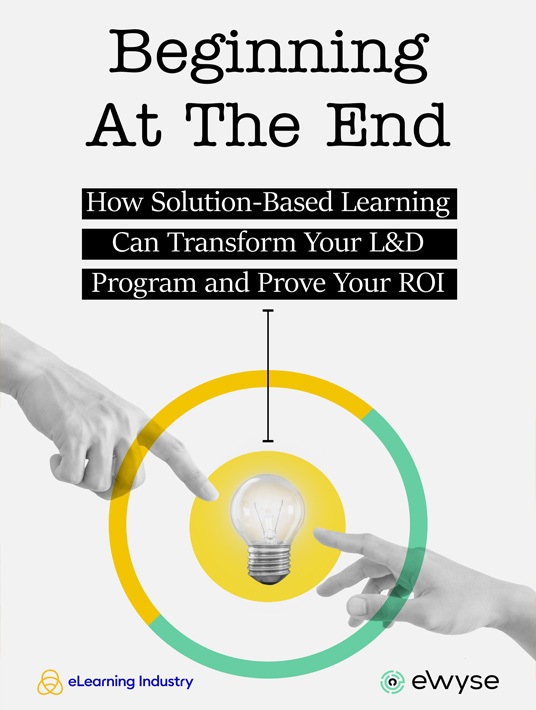Solution-Based Learning Steps To Achieve L&D Success
In our experience, one of the most common mistakes that organizations make is not getting a consultant involved early on. You must be ready and willing to evaluate your current approach or situation to see what's working and what's not before starting the development phase in earnest. For example, assess what your people do now versus what you want them to be able to do after the initiative is completed. One of the solution-based learning golden rules is not skipping any steps along the way. This might seem relatively straightforward, but you'd be surprised by how many people rush through the needs analysis phase or brush over it altogether because they think it's a waste of resources and then wonder why their investment didn't pay off or have the desired effect. Part of the beauty of beginning at the end is that you have the opportunity to set clear, measurable goals first and then start working toward them with a razor-sharp focus.

Which Steps Are Involved In Solution-Based Learning?
Step 0: Consultancy
Some organizations may not have a clear idea of what they need to do or how to achieve it. They know that there's an issue hindering business growth and employee development, but the underlying cause is deep below the L&D surface. That's when it's time to call in the experts to help you trace the symptoms back to the source. This might consist of analyzing LMS metrics, employee surveys, or even workshops with stakeholders in order to determine the issue.
Step 1: Identifying The Problem
What is the problem you are trying to solve? For example, you've seen a surge in workplace errors. It won't do any good to develop task simulations and demo videos if you don't know the reasoning behind these frequent on-the-job mistakes. Is it a matter of irrelevant content? Do employees have the information but aren't sure how to apply it in the real world? Is there a lack of motivation you need to factor into the equation, and why aren't they fully invested in their professional development?
Step 2: Determining If eLearning Is The Right Solution
After identifying the issue, the first question is whether eLearning is even the best option. That's where the solution-based learning approach branches off based on the findings of your needs assessment:
Step 2.1
While it may be avant-garde for an eLearning agency to advocate for solutions other than course development, we have always been a bit unconventional, especially when it comes to helping our clients address their problems head-on. After careful analysis, you might realize that your business management software is the core issue because it no longer aligns with your needs. In this case, online training may not be the best course of action (pun intended), and you may need to consider purchasing a new platform. Unless, of course, you determine that the tech isn't the true culprit, and what you really need is to educate employees on how to properly use the system and maximize functionality.
Step 2.2
If eLearning is the right fit, then you're ready to figure out what people need to know or be able to do when they wrap up the L&D experience. It's also crucial to set measurement tools before diving into the design process. You need to know exactly what you want to accomplish with the learning initiative and how you're going to measure its effectiveness. This allows you to create a strategy that includes objectives, milestones, KPIs, and other crucial metrics that you need to keep track of instead of trying to throw eLearning resources at your employees to see what sticks.
Step 3: Development
This is usually the step that comes first for organizations that take the traditional route. With solution-based learning projects, the development process can only start once you've mapped out your plan and disclosed all of the underlying issues. This is the point where you can break out those storyboards and outlines. An eLearning agency can help you create wow-worthy content that resonates with your learners, bridges gaps, and achieves business outcomes. You can check out our 3C Framework to see how we give all of our clients control over creativity, the process, and the financial aspects of eLearning design.
Step 4: Measure Success
You've already set the parameters for success and rolled out your eLearning initiative. Now it's time to analyze what learners have achieved and whether you've hit your L&D targets. This may involve assessments, learner feedback, customer service scores, performance evaluations, and other criteria that you've decided on in step 2.2. But we don't just hand over the SCORM files and bid you adieu. In fact, this is the stage where one of the most unique aspects of solution-based learning comes into play.
Step 5: Evaluation And Revision
If something is missing the mark, we go back to Step 3 to determine what needs fixing and why. Are learners still unable to move from theory to practice? Do you need to provide more just-in-time support to address performance issues? We pride ourselves on a job well done, and sometimes that means going back to the drawing board to make the experience even more relevant and relatable for your team.
Conclusion
Bringing in an eLearning specialist late in the game after you've already invested countless resources into curriculum development is a missed opportunity. If they're with you from day one, they can help not only conduct a needs analysis but diagnose the "why" behind the problem that's plaguing your business. But how do you know to call in reinforcements and consult an eLearning agency? Our next chapter sheds light on the warning signs that it's time to reach out to an expert.
Download the eBook Beginning At The End: How Solution-Based Learning Can Transform Your L&D Program And Prove Your ROI today to discover how you can leverage the solution-based approach to achieve your objectives and make your eLearning development process more problem-centered.








